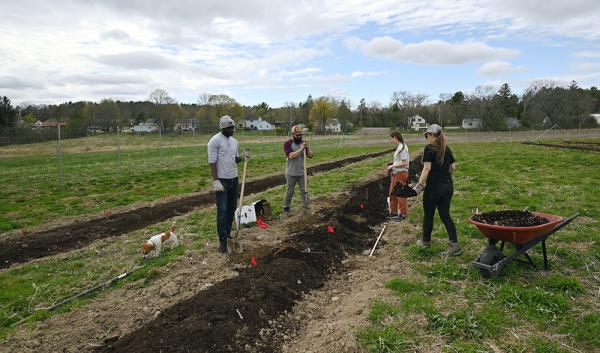Across the northeast, farmers are increasingly looking to chestnuts as a new option for their farms. This interest in chestnuts comes from several angles. U.S. production of chestnuts is much smaller than domestic demand, so chestnut farmers have ready markets for their products.
Chestnuts are a perennial crop that help farmers adapt to, and mitigate, climate change. Finally, farmers are growing chestnuts to diversify their crop production. They use chestnuts as the tree component of agroforestry practices or add chestnut orchards to their farms.
J. Russell Smith, author of the agroforestry classic “Tree Crops: A Permanent Agriculture,” described the chestnut (Castanea spp.), as “the corn that grows on trees.” They are a staple in many European and Asian diets. Chestnuts are nutritionally like brown rice, with 5-7% percent fat, balanced protein, and little sodium.
U.S. production lags domestic demand – the U.S. imports most of the chestnuts it consumes from China and Italy. China produces about 80% of the world’s chestnuts each year. Chestnut farmers in the Midwest regularly sell out of their product in advance or as soon as it’s available. Some farmers offer “u pick” options and find consumers drive long distances from larger metropolitan areas to pick their own chestnuts. As a result of all of this, there’s significant interest among farmers in helping to meet that demand.
Chestnuts are not only a valuable commodity; they are valuable to the long-term profitability and sustainability of the farm.
Chestnut trees can be part of a farmer’s approach to mitigating and adapting to climate change. Perennials, including chestnut trees, generally sequester more carbon than annual vegetation because they grow for more days of the year than annual crops. Also, chestnut trees store more carbon each year because their roots and tops keep growing, unlike annual plants that slowly release carbon as they decompose.
Planting trees can also help with climate adaptation. Intense rainfall events have become more frequent, especially in the Northeast and Midwest. Heavy rains affect agricultural and forested landscapes by increasing the amount of water flowing through streams and rivers, causing field and bank erosion. Forest and tree cover can intercept rainfall, increase the amount of that rain that filters into the ground, and reduce the quantity, speed, and peak flows of runoff. With good design, tree plantings, including chestnuts, can have positive effects at a watershed scale, even if trees are established only in some parts of the landscape.
By establishing more perennial and tree cover on their farms, farmers help to address these challenges. Some farmers are growing chestnuts in orchards. But farmers are also finding ways to add chestnuts to their operation without replacing field crops or pastures. Through agroforestry practices such as alley cropping, silvopasture, hedgerows, windbreaks and living fences, farmers can diversify their fields and income streams. With these practices farmers harvest from the ground to the canopy, while maintaining their current production systems. Experience with adding chestnuts to existing production systems is growing throughout the northeast.
With this increase in chestnut production, there is also a need to better understand and strengthen chestnut growers’ access to markets.
Some farmers find success selling direct to consumers through farmers markets, u-pick, or internet sales. Others find that aggregating, processing, distributing, and marketing chestnuts is more successful when they work together. Over the last few years, partners from the Pennsylvania Chapter of the American Chestnut Foundation, the Pennsylvania Bureau of Forestry, and USDA National Agroforestry Center, along with chestnut farmers have been learning from existing chestnut cooperatives and aggregators across the country. As a result of this work, the group has organized events to build networks among chestnut growers and those involved in aggregation, marketing, and distribution.
Chestnut farmers and many others in the Northeast are working to support the growth and management of this important tree crop. These include distributors, aggregators, and cooperatives, along with the array of agencies and organizations that provide technical and financial assistance.
Learn more about growing chestnuts from the Chestnut Growers of America and the Northern Nut Growers Association or visit the University of Missouri’s Chestnut Publications webpage. If you are interested in connecting with other growers or have other questions, contact Kate MacFarland at Katherine.macfarland@usda.gov.




